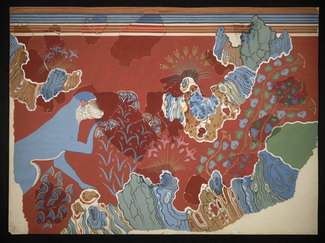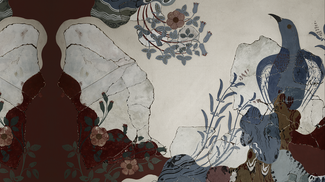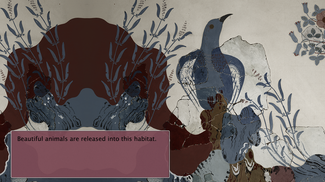Restoring the Minoans: Elizabeth Price and Sir Arthur Evans
This article first appeared in ISAW Newsletter 18 (Spring 2017).
October 5, 2017–January 7, 2018
Rachel Herschman, Curatorial Assistant
 Émile Gilliéron fils, Blue Monkey in a Rocky Landscape. Watercolor on paper, H. 60 cm; W. 83 cm, after a fresco from House of the Frescoes, Knossos, ca. 1928. Ashmolean Museum, University of Oxford: Evans Fresco Drawing C/6.
The British archaeologist Sir Arthur Evans (1851–1941) fundamentally shaped our understanding of the Minoan world. He excavated the “Palace of Minos” on the island of Crete and believed he had found the remnants of Daedalus’s mythological Minotaur-containing labyrinth. As the first person to recognize the distinctiveness of the Minoans, his contribution to archaeology cannot be underestimated, yet his bold restoration of the site at Knossos confronts viewers with images of an ancient world that appear distinctively modern. Art nouveau-styled women and reinforced concrete structures invite questions about the archaeologist’s boundaries between interpretation and speculation.
Émile Gilliéron fils, Blue Monkey in a Rocky Landscape. Watercolor on paper, H. 60 cm; W. 83 cm, after a fresco from House of the Frescoes, Knossos, ca. 1928. Ashmolean Museum, University of Oxford: Evans Fresco Drawing C/6.
The British archaeologist Sir Arthur Evans (1851–1941) fundamentally shaped our understanding of the Minoan world. He excavated the “Palace of Minos” on the island of Crete and believed he had found the remnants of Daedalus’s mythological Minotaur-containing labyrinth. As the first person to recognize the distinctiveness of the Minoans, his contribution to archaeology cannot be underestimated, yet his bold restoration of the site at Knossos confronts viewers with images of an ancient world that appear distinctively modern. Art nouveau-styled women and reinforced concrete structures invite questions about the archaeologist’s boundaries between interpretation and speculation.
When the Turner Prize-winning artist Elizabeth Price (British, b. 1966) was commissioned to create a new artwork based on the collection of the Ashmolean Museum, she was drawn to the modern watercolors and photographs in the Sir Arthur Evans Archive. Her eighteen-minute video installation takes creative license with the museum’s archive in response to Evans’s blurred boundaries between artifact, restoration, and invention. A RESTORATION (2016) reinterprets Evans’s images from his archaeological excavation by layering them with rhythmic electronic music and synthetically voiced narrators to drive a new story that is as much about the past as it is about the future.
Presenting artifacts from Minoan Crete, archival materials from the Sir Arthur Evans Archive, together with the work of Elizabeth Price, this exhibition explores the relationship between restoration and art. How do archaeologists and museums recover long-silent civilizations and make them meaningful for us today? How do contemporary conditions influence the way we understand the past? This exhibition presents the dynamics between recovery and creation using a work of a contemporary video art as a lens on the ancient past.


Watercolor representation of the Minoan “Bluebird” fresco restored by Émile Gilliéron fils. From Elizabeth Price, A RESTORATION. Video/installation, 2016. Presented by the Contemporary Art Society, Ashmolean Museum, University of Oxford: WA2017.87.